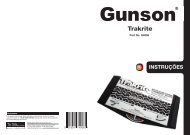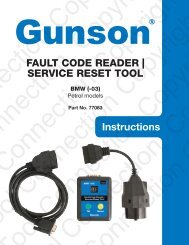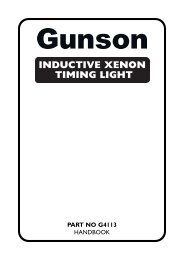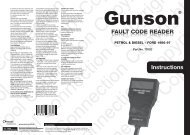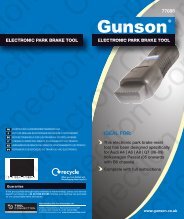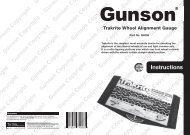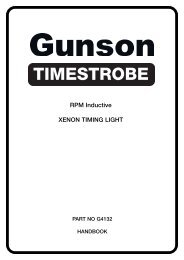POCKETMETER 2 - Gunson
POCKETMETER 2 - Gunson
POCKETMETER 2 - Gunson
You also want an ePaper? Increase the reach of your titles
YUMPU automatically turns print PDFs into web optimized ePapers that Google loves.
<strong>Gunson</strong> Timestrobe<br />
6.RESISTANCE<br />
Pocketmeter has 5 resistance (Ohms ø) ranges, selected by the central FUNCTION switch, as follows:<br />
0 to 200 Ohms<br />
0 to 2K Ohms (ie 0 to 2000 Ohms)<br />
0 to 20K Ohms (ie 0 to 20,000 Ohms)<br />
0 to 200K Ohms (ie 0 to 200,000 Ohms)<br />
0 to 2M Ohms (ie 0 to 2,000,000 Ohms)<br />
These ranges are used for measurements of resistance where the resistance of particular components<br />
are known from a data manual or a vehicle technical handbook. For instance, the 0 to 200<br />
Ohm range is valuable for testing parts of the ignition Low Tension (LT) circuit on a vehicle, the 0<br />
to 200K Ohm range for testing parts of the ignition High Tension (HT) circuit (such as plug leads),<br />
and the other ranges for testing particular circuit elements, sensors etc. The 0 to 20M Ohm<br />
range is particularly useful for testing insulation.<br />
When measuring resistance, Pocketmeter passes a very small electrical current through the circuit/component<br />
being tested. It is therefore essential that the circuit/component being tested is<br />
electrically "dead" (ie is disconnected from any electrical supply). Otherwise, Pocketmeter may<br />
be damaged. Some internal protection is provided, but it is good practice not to put it to the<br />
test. In any case, readings taken on a circuit that is not electrically "dead" will be meaningless.<br />
Because current is drawn from the internal battery for resistance tests, any tests made, particularly<br />
on the lowest range, 0 - 200 Ohms, should be brief so as to minimise the current drawn from<br />
the internal battery (this proviso also applies to "Continuity" and "Diode" tests, which follow).<br />
INSTRUCTIONS FOR USE - when measuring resistance<br />
(a) Ensure that the circuit/component to be tested is electrically "dead", ie is not connected to<br />
any electrical supply.<br />
(b) Set the central FUNCTION switch to a resistance range<br />
Touch the RED and BLACK PROBES to the circuit/component to be tested.<br />
(c) Observe the reading on the display. If the over-range indication is displayed (1___.), turn the<br />
switch to a higher resistance range (this may be done without disconnecting the leads).<br />
(d) After use, disconnect the leads from the circuit/component, and return the FUNCTION<br />
switch to the "OFF" position.<br />
7. CONTINUITY TEST<br />
The "Continuity" function is used to measure whether wiring is "continuous", or whether it has a<br />
break.<br />
The circuit to be tested needs to be electrically isolated i.e. "dead" for this test to be carried out.<br />
To use the Continuity Test, simply set the central switch to CONTINUITY, and touch the probes at<br />
either end of the wiring to be tested.<br />
8





